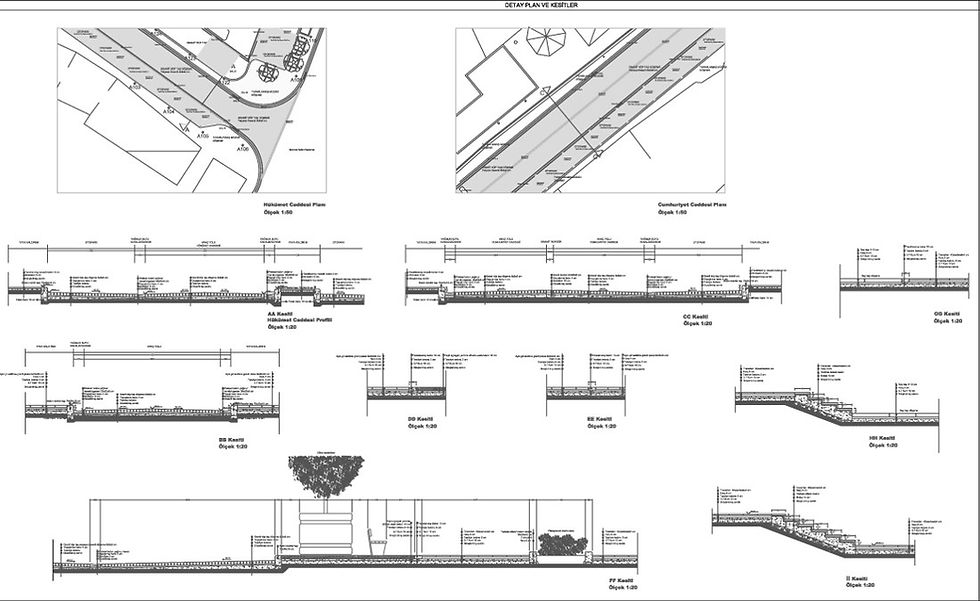BUILT DESIGN WORK
These urban design projects were commissioned by municipalities in the Mersin Province between 2010 and 2016. All three sites are officially registered as archeological or natural heritage sites protected under special laws, which meant that there were strict limitations on possible interventions and the projects had to be approved by the regional Cultural Heritage Protection Council. In all of these projects, both the social and natural circumstances of the sites provided the basic references for design decisions.








































Project Date: 2011
Site: Mut, Mersin, Turkey
Client: Municipality of Mut
Design team: Esra Şahin Burat (architect), Sinan Burat (landscape architect)
Construction completed in 2012.
Mut Çınaraltı Park Renovation, 2011
The project involved renovation of the “central park” of the historic town of Mut, located in the bounds of the Mersin Province. Situated between the Mut River, the historic Mut Castle, a 16th century mosque, and the historic caravan route, the park has been the social center of the downtown. It harbors centuries-old and officially registered majestic plane trees which are fed by an ancient spring located beneath the park. During the hot and dry summer months, the trees and the spring that fills the pools create a pleasant micro-climate which attracts the public for a variety of recreational uses. The activities of the annual apricot harvest festival takes place in the park. It also harbors statue of a folk poet who lived in the town in the 16th century, a national folk hero. The project involved replacing the wall which divided the park with an open seating area and providing a stage in the front, renovating all the ground surfaces, designing the urban furniture, lighting, and landscaping, and re-constructing the pools that are fed by the spring beneath. The project was awarded "Project Implementation Support" by the regional Development Agency. Construction was completed in 2012.














Project Date: 2012
Site: Mut, Mersin, Turkey
Client: Municipality of Mut
Design team: Esra Şahin Burat (architect), Sinan Burat (landscape architect), Tolga Levent (city planner)
Construction completed in 2016.
Mut Cumhuriyet Square and City Center Renovation, 2012
The project site was not only the historic center of the town of Mut (bordered with a 16th century mosque, a historic castle, and the park that was previously renovated), it is also the administrational center bordered with the municipal headquarters, and the commercial center lined with shops. The central void that was situated between these elements –the “heart” of the town- lacked any form of organization and it was used as a makeshift parking lot. The design team limited the area of car-accessible areas, re-structured the traffic pattern, introduced limited number of parking areas, proposed new pavements both for the roads and all the pedestrian areas, and introduced various types of lighting fixtures and landscaping elements. The center of the site was cleared from cars and supplied with a ceremonial square for celebrations. Mut Municipality acquired funding for implementation from the provincial government based on the merit of the project. Construction was completed in October 2016 and the official opening is due summer 2017.






















Project Date: 2016
Site: Mezitli, Mersin, Turkey
Client: Municipality of Mezitli
Design Team: Sema Uğurlu (architect), Esra Şahin Burat (design consultant)
Construction completed in 2016.
Viranşehir Street Pedestrian and Bicycle Path, 2016
The project involved designing a pedestrian path and a bicycle road alongside the Colonnaded Street (cardo maximus) of the Roman city of Soli Pompeiopolis. Situated between the Roman street and orange groves, Viranşehir Street not only overlooks the excavations of the Colonnaded Street, parts of which have been restored, but also forms an urban connector that links the recreational seaside (where the impressive ruins of the Roman port are located) to the south with the inner commercial areas to the north. Used as a passageway, it provided no reference to the archeological remains and had no articulation that invited stationary activities. The design team proposed a paved pedestrian path with changing widths, which allows stationary activities such as resting, observing the excavations, reading the information boards, having picnics and small-scale art performances. Various types of lighting fixtures, fragrant and flowering plants, several types of benches, information boards, and a fountain were introduced. A wood-floored stage and a small seating area is provided at the point where the decumanus of the ancient town is believed to be intersecting with the cardo. And a bike path, which can also be used as an emergency exit and a service road for the orchards, connects to the shore. The project was approved by the regional Cultural Heritage Protection Council and the construction was completed in December 2016. The official opening took place on December 24, 2016.